Jackson M.J. Micro and Nanomanufacturing
Подождите немного. Документ загружается.

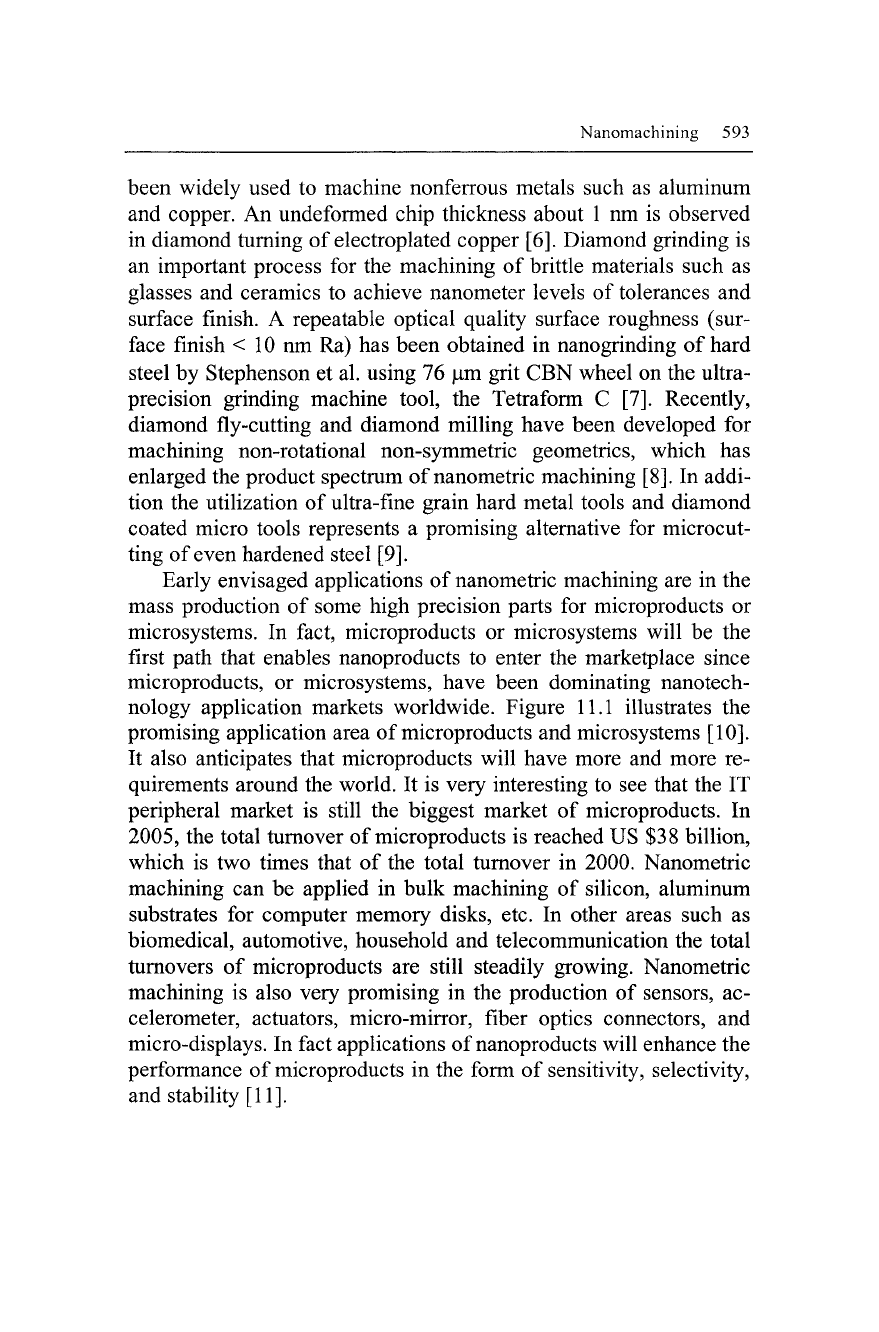
Nanomachining 593
been widely used to machine nonferrous metals such as aluminum
and copper. An undeformed chip thickness about 1 nm is observed
in diamond turning of electroplated copper [6]. Diamond grinding is
an important process for the machining of brittle materials such as
glasses and ceramics to achieve nanometer levels of tolerances and
surface finish. A repeatable optical quality surface roughness (sur-
face finish < 10 nm Ra) has been obtained in nanogrinding of hard
steel by Stephenson et al. using 76 |um grit CBN wheel on the ultra-
precision grinding machine tool, the Tetraform C [7]. Recently,
diamond fly-cutting and diamond milling have been developed for
machining non-rotational non-symmetric geometries, which has
enlarged the product spectrum of nanometric machining [8]. In addi-
tion the utilization of ultra-fine grain hard metal tools and diamond
coated micro tools represents a promising alternative for microcut-
ting of even hardened steel [9].
Early envisaged applications of nanometric machining are in the
mass production of some high precision parts for microproducts or
microsystems. In fact, microproducts or microsystems will be the
first path that enables nanoproducts to enter the marketplace since
microproducts, or microsystems, have been dominating nanotech-
nology application markets worldwide. Figure 11.1 illustrates the
promising application area of microproducts and microsystems [10].
It also anticipates that microproducts will have more and more re-
quirements around the world. It is very interesting to see that the IT
peripheral market is still the biggest market of microproducts. In
2005,
the total turnover of microproducts is reached US $38 billion,
which is two times that of the total turnover in 2000. Nanometric
machining can be applied in bulk machining of silicon, aluminum
substrates for computer memory disks, etc. In other areas such as
biomedical, automotive, household and telecommunication the total
turnovers of microproducts are still steadily growing. Nanometric
machining is also very promising in the production of sensors, ac-
celerometer, actuators, micro-mirror, fiber optics connectors, and
micro-displays. In fact applications of nanoproducts will enhance the
performance of microproducts in the form of sensitivity, selectivity,
and stability [11].
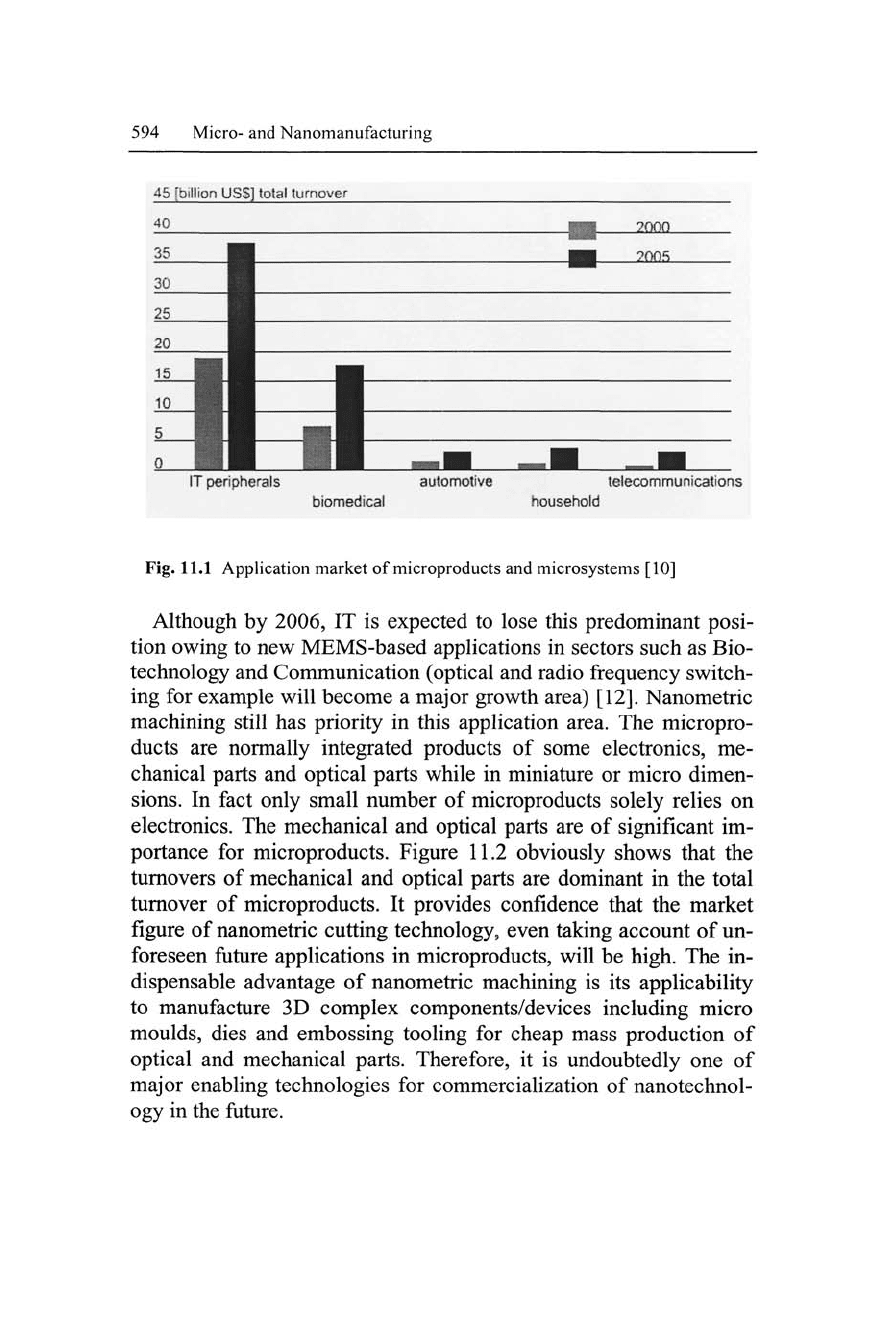
594 Micro- and Nanomanufacturing
45 [billion USS] toial turnover
40
•
rr'^t^
[..:...i:A
?000
?onh
H
" 1
H
'' •! •
^°
II 1
s 11
.1
IT peripherals automotive lelecommunications
biomedical household
Fig. 11.1 Application market of microproducts and microsystems [10]
Although by 2006, IT is expected to lose this predominant posi-
tion owing to new MEMS-based applications in sectors such as Bio-
technology and Communication (optical and radio frequency switch-
ing for example will become a major growth area) [12]. Nanometric
machining still has priority in this application area. The micropro-
ducts are normally integrated products of some electronics, me-
chanical parts and optical parts while in miniature or micro dimen-
sions.
In fact only small number of microproducts solely relies on
electronics. The mechanical and optical parts are of significant im-
portance for microproducts. Figure 11.2 obviously shows that the
turnovers of mechanical and optical parts are dominant in the total
turnover of microproducts. It provides confidence that the market
figure of nanometric cutting technology, even taking account of un-
foreseen future applications in microproducts, will be high. The in-
dispensable advantage of nanometric machining is its applicability
to manufacture 3D complex components/devices including micro
moulds, dies and embossing tooling for cheap mass production of
optical and mechanical parts. Therefore, it is undoubtedly one of
major enabhng technologies for commercialization of nanotechnol-
ogy in the future.
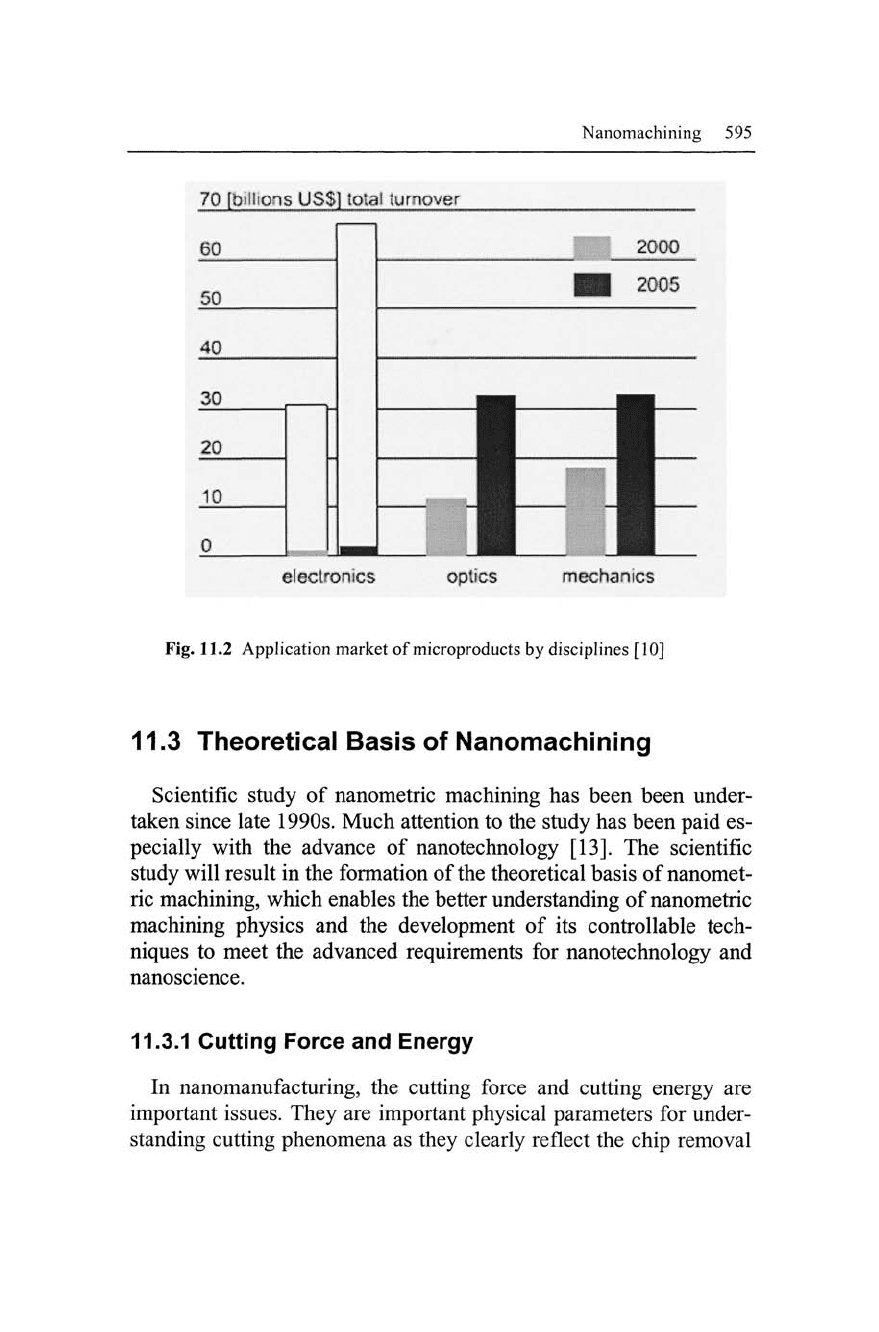
Nanomachinmg 595
70 [billions USS] iotal turnover
60
50
40
30
20
H
10
11
0
1 III
2000
H 2Q05
ki
eleclronics
optics mechanics
Fig. 11.2 Application market of microproducts by disciplines [10]
11.3 Theoretical Basis of Nanomachining
Scientific study of nanometric machining has been been under-
taken since late 1990s. Much attention to the study has been paid es-
pecially with the advance of nanotechnology [13]. The scientific
study will result in the formation of the theoretical basis of nanomet-
ric machining, which enables the better understanding of nanometric
machining physics and the development of its controllable tech-
niques to meet the advanced requirements for nanotechnology and
nanoscience.
11.3.1 Cutting Force and Energy
In nanomanufacturing, the cutting force and cutting energy are
important issues. They are important physical parameters for under-
standing cutting phenomena as they clearly reflect the chip removal
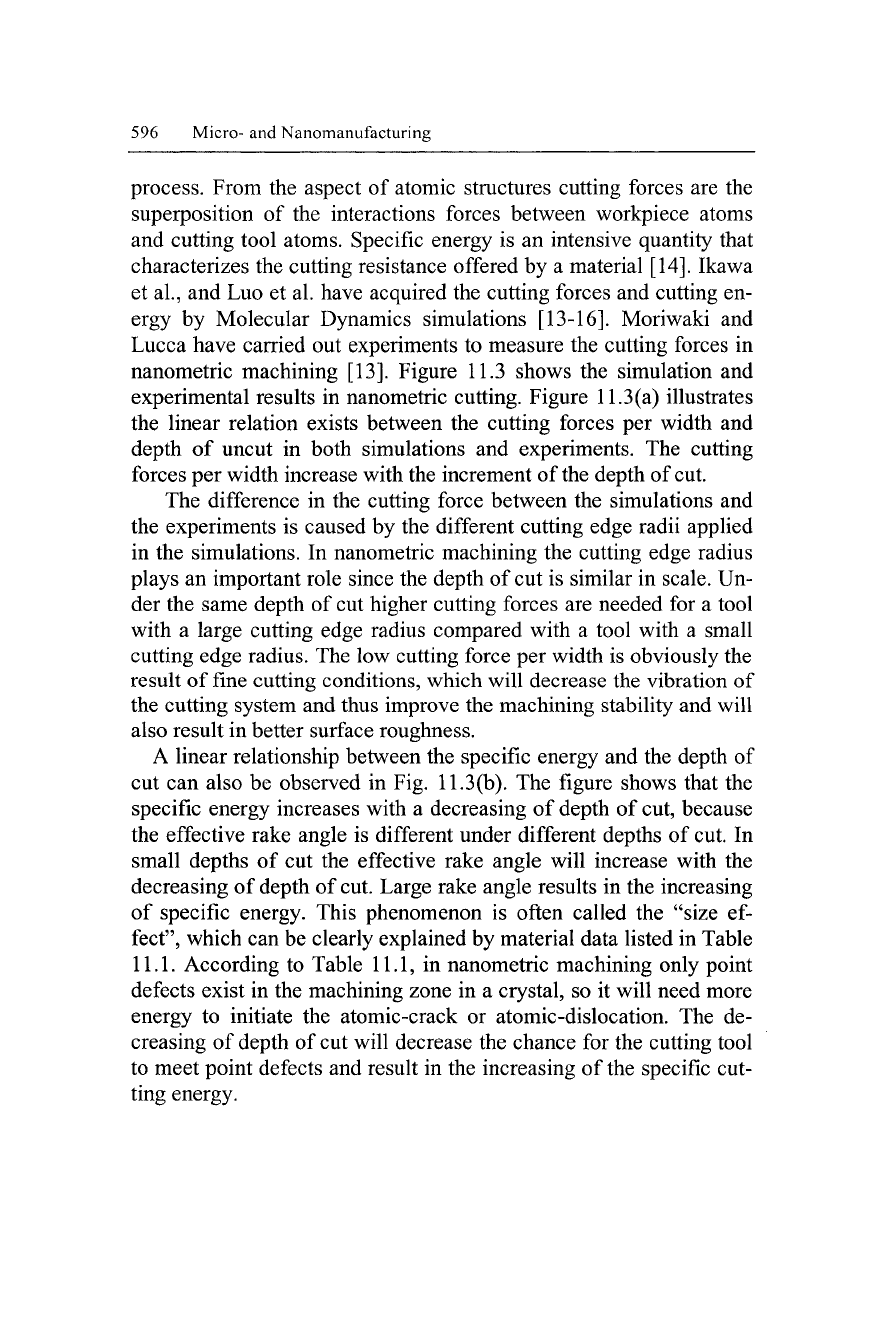
596 Micro- and Nanomanufacturing
process. From the aspect of atomic structures cutting forces are the
superposition of the interactions forces between workpiece atoms
and cutting tool atoms. Specific energy is an intensive quantity that
characterizes the cutting resistance offered by a material [14]. Ikawa
et al., and Luo et al. have acquired the cutting forces and cutting en-
ergy by Molecular Dynamics simulations [13-16]. Moriwaki and
Lucca have carried out experiments to measure the cutting forces in
nanometric machining [13]. Figure 11.3 shows the simulation and
experimental results in nanometric cutting. Figure 11.3(a) illustrates
the linear relation exists between the cutting forces per width and
depth of uncut in both simulations and experiments. The cutting
forces per width increase with the increment of the depth of cut.
The difference in the cutting force between the simulations and
the experiments is caused by the different cutting edge radii applied
in the simulations. In nanometric machining the cutting edge radius
plays an important role since the depth of cut is similar in scale. Un-
der the same depth of cut higher cutting forces are needed for a tool
with a large cutting edge radius compared with a tool with a small
cutting edge radius. The low cutting force per width is obviously the
result of fine cutting conditions, which will decrease the vibration of
the cutting system and thus improve the machining stability and will
also result in better surface roughness.
A linear relationship between the specific energy and the depth of
cut can also be observed in Fig. 11.3(b). The figure shows that the
specific energy increases with a decreasing of depth of cut, because
the effective rake angle is different under different depths of cut. In
small depths of cut the effective rake angle will increase with the
decreasing of depth of
cut.
Large rake angle results in the increasing
of specific energy. This phenomenon is often called the "size ef-
fect", which can be clearly explained by material data listed in Table
11.1.
According to Table 11.1, in nanometric machining only point
defects exist in the machining zone in a crystal, so it will need more
energy to initiate the atomic-crack or atomic-dislocation. The de-
creasing of depth of cut will decrease the chance for the cutting tool
to meet point defects and result in the increasing of the specific cut-
ting energy.
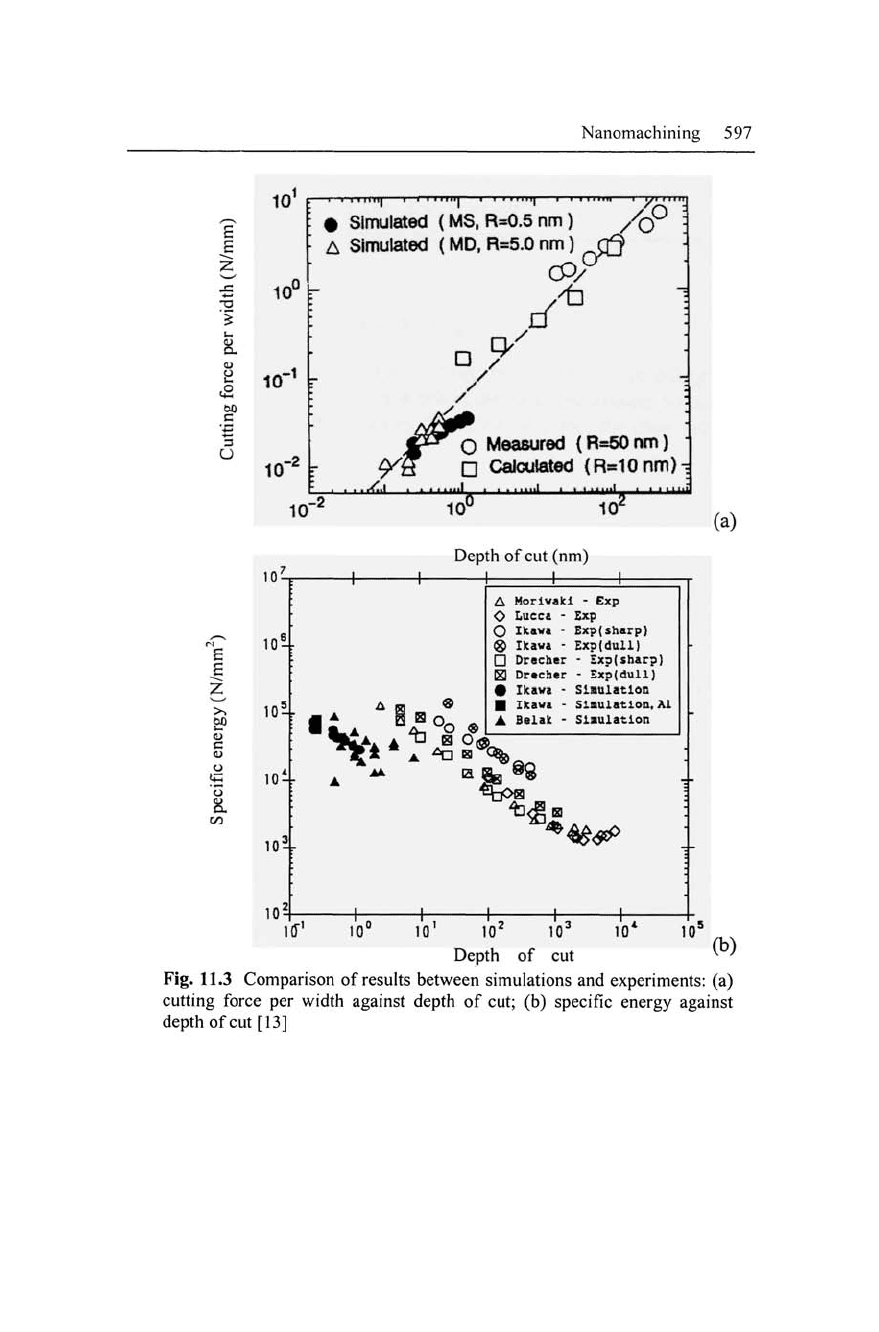
Nanomachining
597
E
B
-S
S.
a
U
£
o
c
E.
10'
10"
10'
-1
10"
I
> 1 1
I1TT|
1—I 1
'TTHj
1—r T
TTrrt^
1—r-r
# Simulated
(
MS,
R:=0.5
nm
)
A Simulated (MD, R=5.0
nm) n^
CP/
or
—I—nrm-rn]
i>.n»iX
II
ri
O Measured {R=50nm)
•
Calcutated (RslOnm)-^
J-a—t..t.,.*iittAliii
1 I,,
10"
10" 10'
r
Depth
of
cut
(nm)
I
I I
(a)
ICT'
10 10
10*
10=
(b)
10^
10
Depth
of cut
Fig.
11.3
Comparison
of
results between simulations
and
experiments:
(a)
cutting force
per
width against depth
of
cut;
(b)
specific energy against
depth
of
cut
[13]
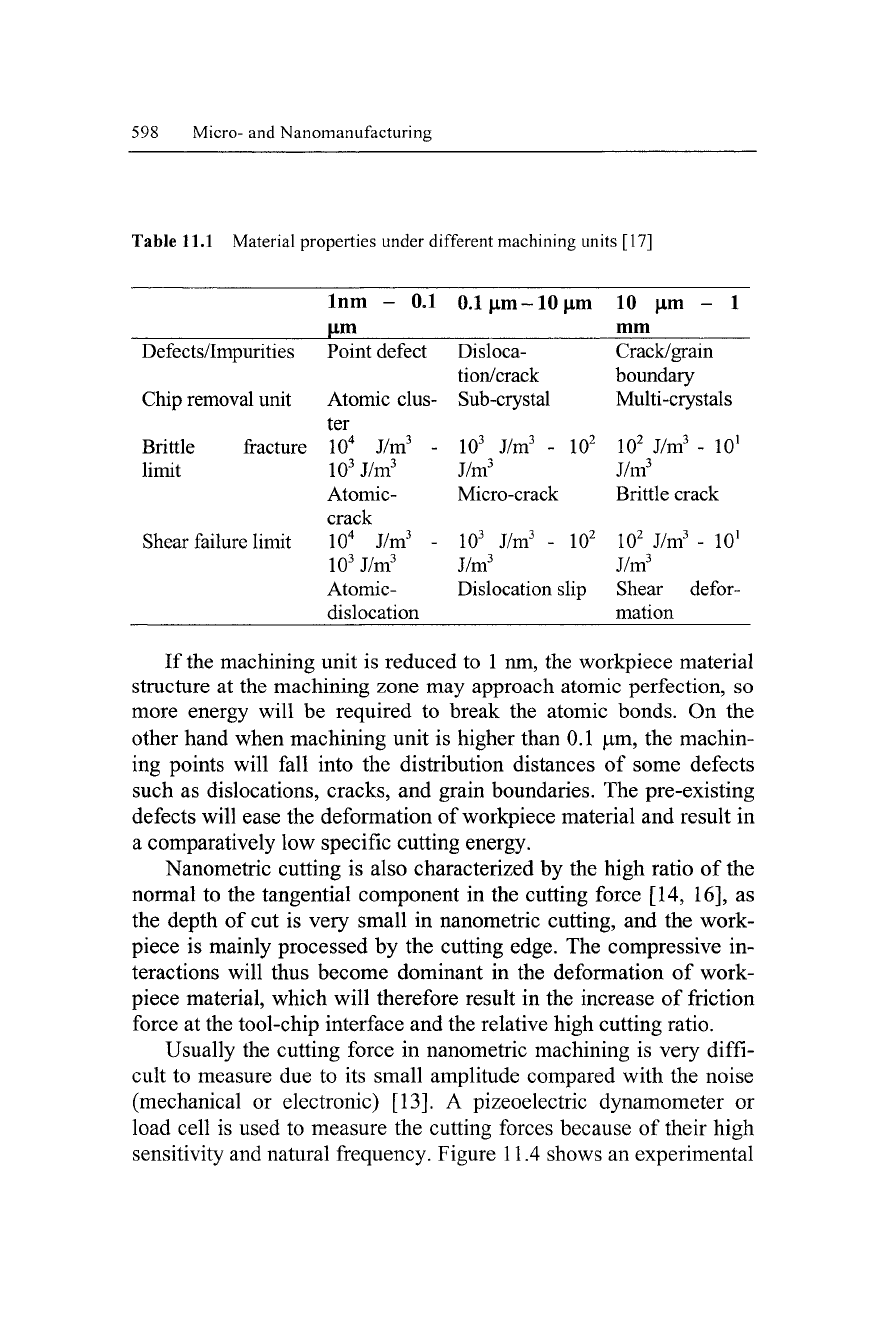
598 Micro- and Nanomanufacturing
Table 11.1 Material properties under different machining units [17]
Inm - 0,1 0.1 Jim-10 urn 10 urn - 1
\im mm
Defects/Impurities Point defect Disloca- Crack/grain
tion/crack boundary
Chip removal unit Atomic clus- Sub-crystal Multi-crystals
ter
Brittle fracture
limit
Shear failure limit
lO"
J/m' -
10^
J/m^
Atomic-
crack
10"
J/m^ -
10'
J/m'
Atomic-
dislocation
10'
J/m' - 10^
J/m^
Micro-crack
10'
J/m' - 10^
J/m'
Dislocation slip
10^
J/m' - 10'
J/m'
Brittle crack
10^
J/m' - 10'
J/m'
Shear defor-
mation
If the machining unit is reduced to 1 nm, the workpiece material
structure at the machining zone may approach atomic perfection, so
more energy will be required to break the atomic bonds. On the
other hand when machining unit is higher than 0.1 |Lim, the machin-
ing points will fall into the distribution distances of some defects
such as dislocations, cracks, and grain boundaries. The pre-existing
defects will ease the deformation of workpiece material and result in
a comparatively low specific cutting energy.
Nanometric cutting is also characterized by the high ratio of the
normal to the tangential component in the cutting force [14, 16], as
the depth of cut is very small in nanometric cutting, and the work-
piece is mainly processed by the cutting edge. The compressive in-
teractions will thus become dominant in the deformation of work-
piece material, which will therefore result in the increase of friction
force at the tool-chip interface and the relative high cutting ratio.
Usually the cutting force in nanometric machining is very diffi-
cult to measure due to its small amplitude compared with the noise
(mechanical or electronic) [13]. A pizeoelectric dynamometer or
load cell is used to measure the cutting forces because of their high
sensitivity and natural frequency. Figure 11.4 shows an experimental
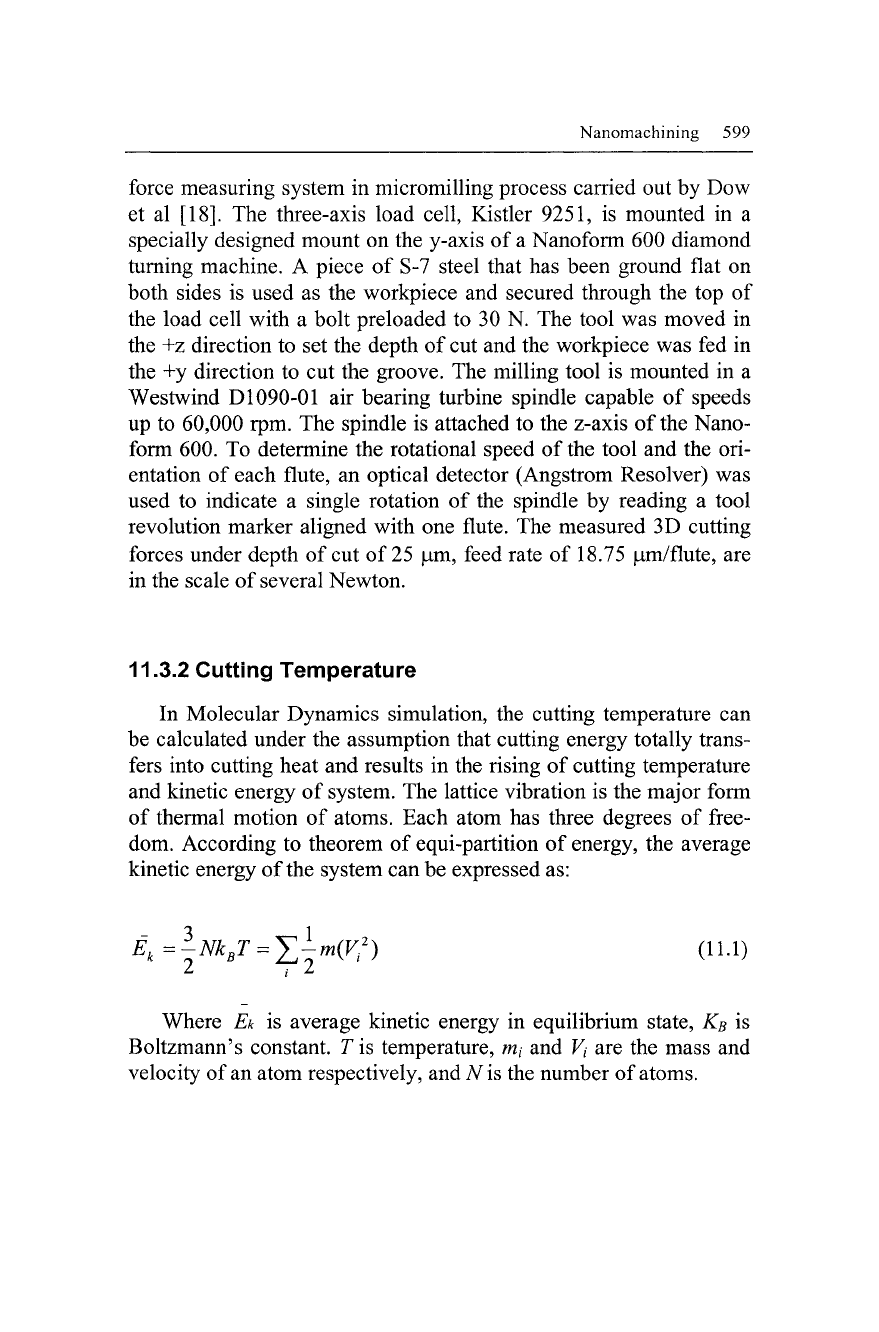
Nanomachining 599
force measuring system in micromilling process carried out by Dow
et al [18]. The three-axis load cell, Kistler 9251, is mounted in a
specially designed mount on the y-axis of a Nanoform 600 diamond
turning machine. A piece of S-7 steel that has been ground flat on
both sides is used as the workpiece and secured through the top of
the load cell with a bolt preloaded to 30 N. The tool was moved in
the +z direction to set the depth of cut and the workpiece was fed in
the +y direction to cut the groove. The milling tool is mounted in a
Westwind D1090-01 air bearing turbine spindle capable of speeds
up to 60,000 rpm. The spindle is attached to the z-axis of the Nano-
form 600. To determine the rotational speed of the tool and the ori-
entation of each flute, an optical detector (Angstrom Resolver) was
used to indicate a single rotation of the spindle by reading a tool
revolution marker aligned with one flute. The measured 3D cutting
forces under depth of cut of 25 |Lim, feed rate of 18.75 |Lim/flute, are
in the scale of several Newton.
11.3.2 Cutting Temperature
In Molecular Dynamics simulation, the cutting temperature can
be calculated under the assumption that cutting energy totally trans-
fers into cutting heat and results in the rising of cutting temperature
and kinetic energy of system. The lattice vibration is the major form
of thermal motion of atoms. Each atom has three degrees of free-
dom. According to theorem of equi-partition of energy, the average
kinetic energy of the system can be expressed as:
E,=^NkJ
=
Y}^m{Vl)
(11.1)
Where Ek is average kinetic energy in equilibrium state, KB is
Boltzmann's constant. 7 is temperature, m/ and Vt are the mass and
velocity of an atom respectively, and
A'^
is
the number of atoms.
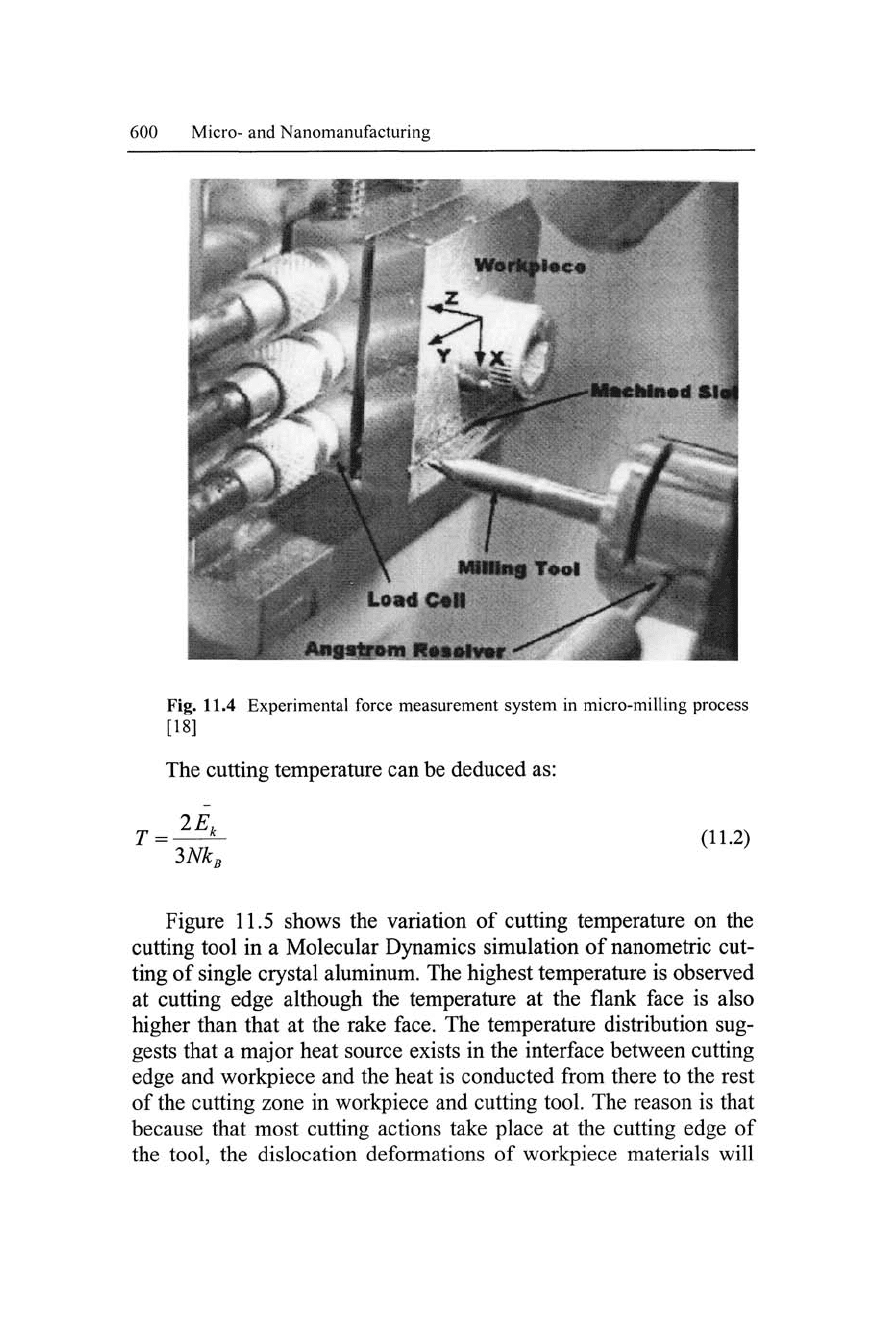
600 Micro- and Nanomanufacturing
Fig. 11.4 Experimental force measurement system in micro-milling process
[18]
r
=
The cutting temperature can be deduced as:
2£.
3M„
(11.2)
Figure 11.5 shows the variation of cutting temperature on the
cutting tool in a Molecular Dynamics simulation of nanometric cut-
ting of single crystal aluminum. The highest temperature is observed
at cutting edge although the temperature at the flank face is also
higher than that at the rake face. The temperature distribution sug-
gests that a major heat source exists in the interface between cutting
edge and workpiece and the heat is conducted from there to the rest
of the cutting zone in workpiece and cutting tool. The reason is that
because that most cutting actions take place at the cutting edge of
the tool, the dislocation deformations of workpiece materials will
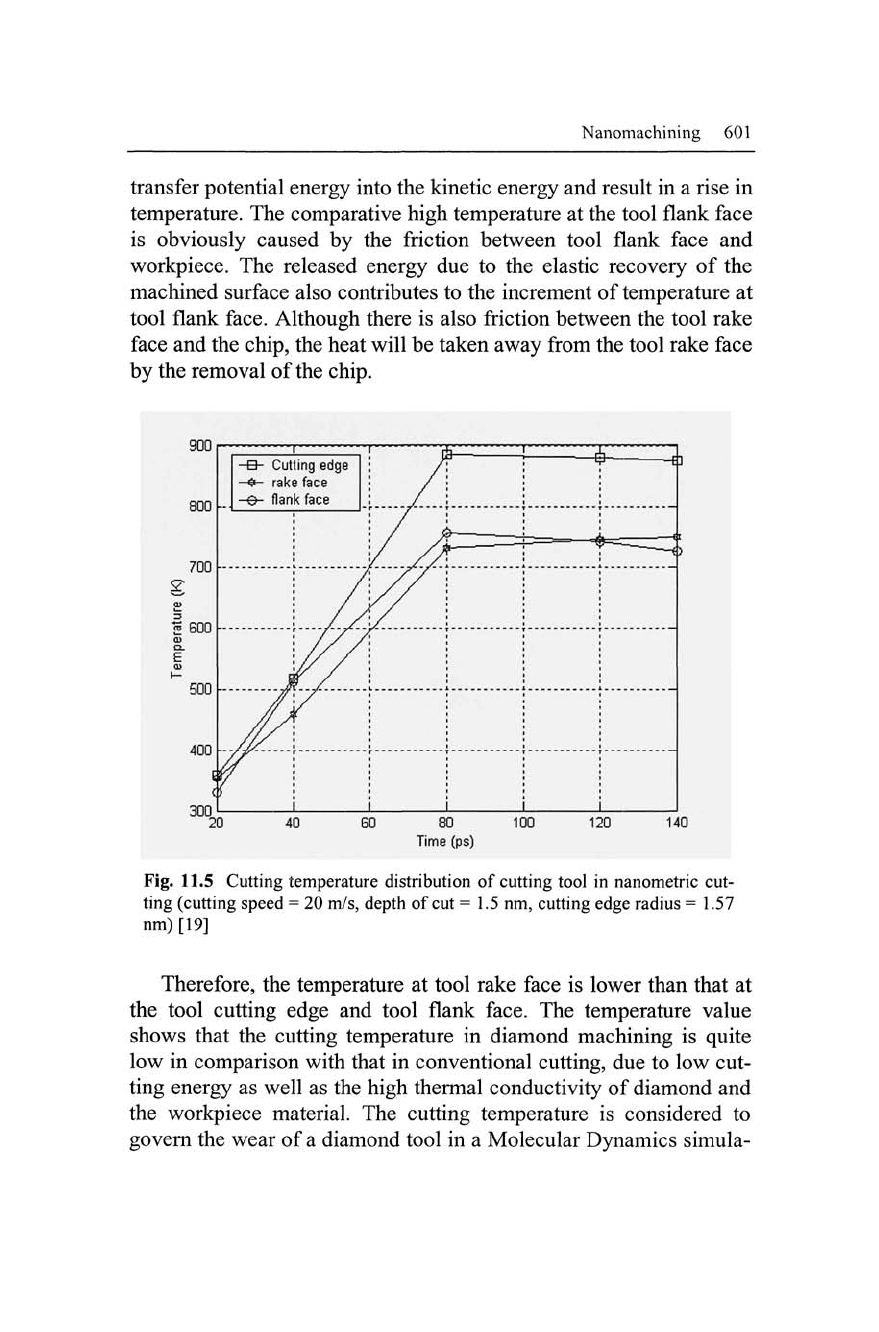
Nanomachining 601
transfer potential energy into the kinetic energy and result in a rise in
temperature. The comparative high temperature at the tool flank face
is obviously caused by the friction between tool flank face and
workpiece. The released energy due to the elastic recovery of the
machined surface also contributes to the increment of temperature at
tool flank face. Although there is also friction between the tool rake
face and the chip, the heat will be taken away from the tool rake face
by the removal of the chip.
900
-B-
Cutting edge
—^ rake face
~&-
flank face
80
Tinne (ps)
Fig. 11.5 Cutting temperature distribution of cutting tool in nanometric cut-
ting (cutting speed = 20 m/s, depth of cut = 1.5 nm, cutting edge radius = 1.57
nm) [19]
Therefore, the temperature at tool rake face is lower than that at
the tool cutting edge and tool flank face. The temperature value
shows that the cutting temperature in diamond machining is quite
low in comparison with that in conventional cutting, due to low cut-
ting energy as well as the high thermal conductivity of diamond and
the workpiece material. The cutting temperature is considered to
govern the wear of a diamond tool in a Molecular Dynamics simula-
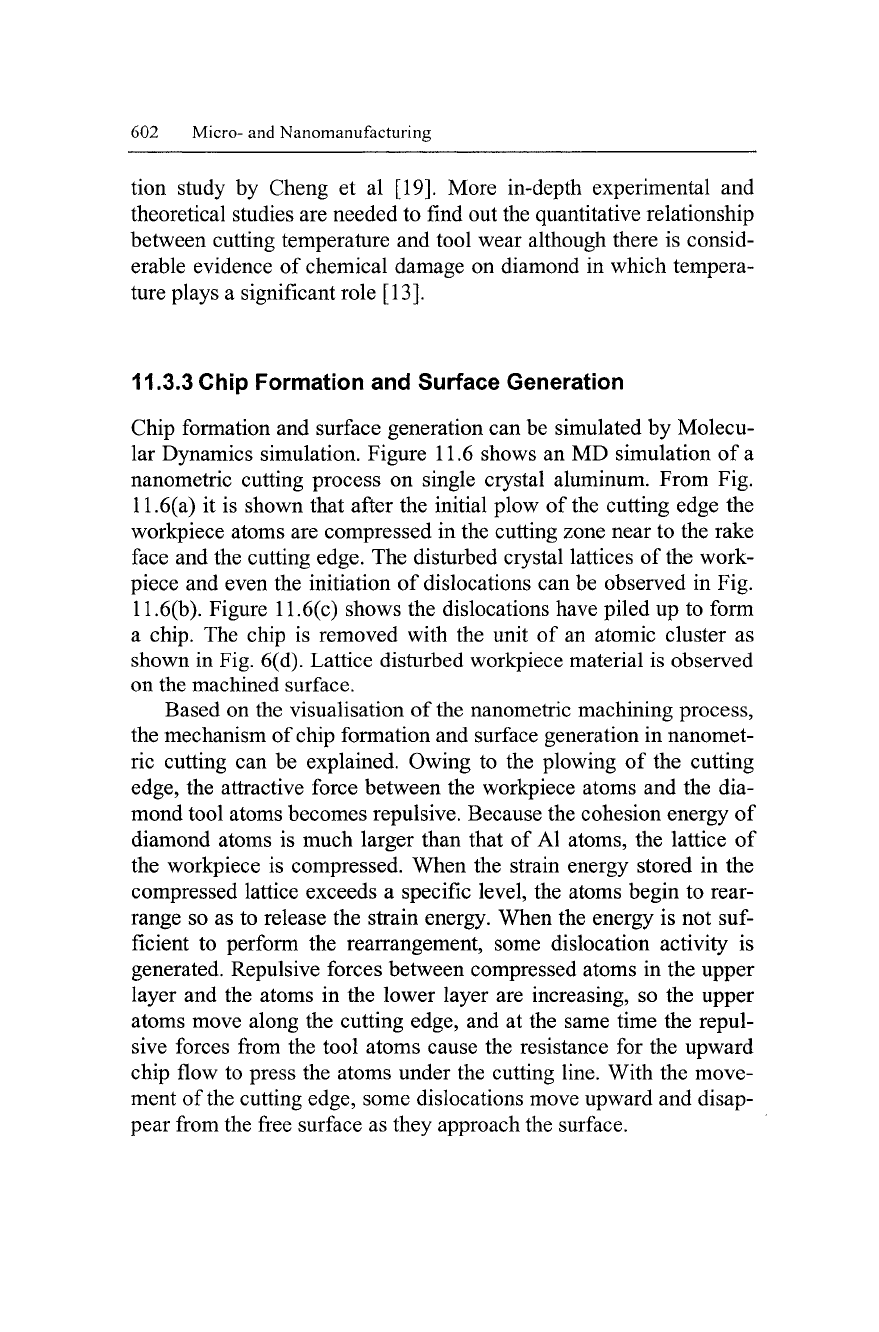
602 Micro- and Nanomanufacturing
tion study by Cheng et al [19]. More in-depth experimental and
theoretical studies are needed to find out the quantitative relationship
between cutting temperature and tool wear although there is consid-
erable evidence of chemical damage on diamond in which tempera-
ture plays a significant role [13].
11.3.3 Chip Formation and Surface Generation
Chip formation and surface generation can be simulated by Molecu-
lar Dynamics simulation. Figure 11.6 shows an MD simulation of a
nanometric cutting process on single crystal aluminum. From Fig.
11.6(a) it is shown that after the initial plow of the cutting edge the
workpiece atoms are compressed in the cutting zone near to the rake
face and the cutting edge. The disturbed crystal lattices of the work-
piece and even the initiation of dislocations can be observed in Fig.
11.6(b).
Figure 11.6(c) shows the dislocations have piled up to form
a chip. The chip is removed with the unit of an atomic cluster as
shown in Fig. 6(d). Lattice disturbed workpiece material is observed
on the machined surface.
Based on the visualisation of the nanometric machining process,
the mechanism of chip formation and surface generation in nanomet-
ric cutting can be explained. Owing to the plowing of the cutting
edge,
the attractive force between the workpiece atoms and the dia-
mond tool atoms becomes repulsive. Because the cohesion energy of
diamond atoms is much larger than that of Al atoms, the lattice of
the workpiece is compressed. When the strain energy stored in the
compressed lattice exceeds a specific level, the atoms begin to rear-
range so as to release the strain energy. When the energy is not
suf-
ficient to perform the rearrangement, some dislocation activity is
generated. Repulsive forces between compressed atoms in the upper
layer and the atoms in the lower layer are increasing, so the upper
atoms move along the cutting edge, and at the same time the repul-
sive forces from the tool atoms cause the resistance for the upward
chip flow to press the atoms under the cutting line. With the move-
ment of the cutting edge, some dislocations move upward and disap-
pear from the free surface as they approach the surface.
